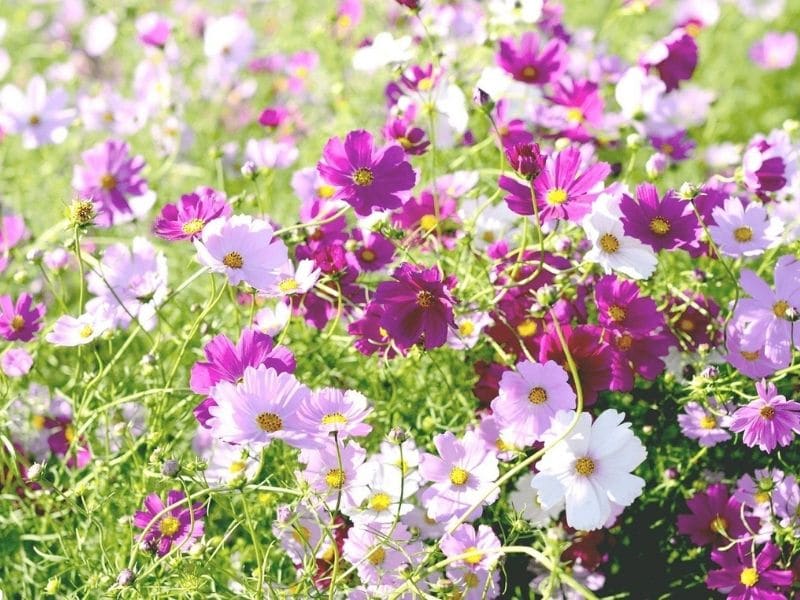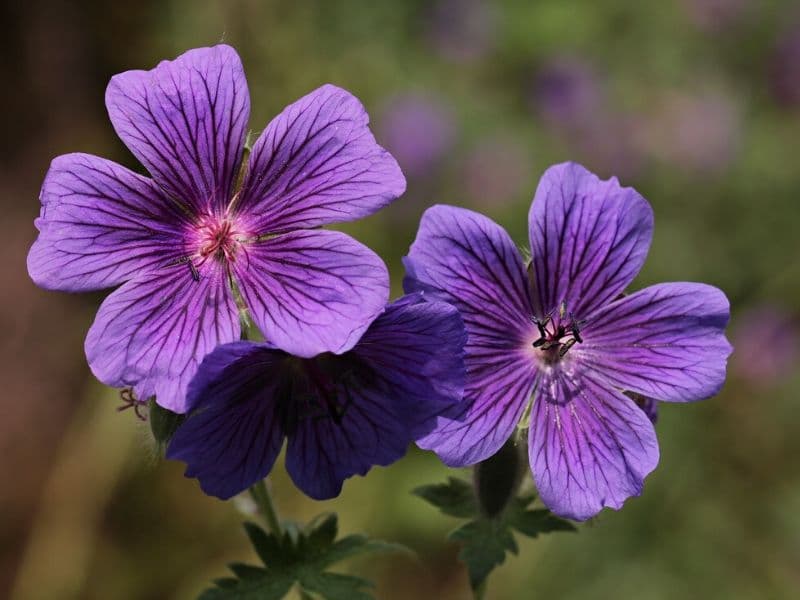For most flowers, heat and sun are essential to both vital growth and the blooming flowers, but all plants have their limits. For this reason, there are many flowers that cannot be grown in locations that have brutally hot summer months or those that do not receive much water.
Thankfully, there are flowers that have adapted to grow in even the hottest regions, giving the hot-climate gardener some options when it comes to planting a flower bed or landscaping.
Most heat-resistant flowers grow best in full sun and are accustomed to the heavy amount of sunlight that often goes hand-in-hand with high temperatures.
Many heat-resistant flowers also grow well in poor soil conditions that are correlated with climates that have warmer temperatures.
Since water shortages are more common in warmer climates, a majority of these flowers are also drought-resistant, which may be important if you are not available to water your flower beds every day.
Here are some heat-resistant flowers that would look great in any flower garden!
#1. Cosmos

Cosmos, Cosmos bipinnatus, are a popular flower choice among almost every growing climate. Although they are generally grown as annuals, some varieties can be grown as perennials in USDA hardiness zones nine and higher. In this case, these flowers actually require high temperatures to grow as perennials.
These brightly colored flowers are native to Mexico, which is why they thrive in warm weather and dry climates. Soil conditions do not have to be perfect for the cosmos to grow. They have been known to grow in dry sandy soil, which is more common in areas with high temperatures.
Cosmos come in shades of pink, orange, and white and bloom into simple, elegant flowers that resemble daisies. These flowers are known for their ability to attract butterflies, birds, and bees into your garden—a welcomed site for most gardeners.
#2. Marigold

The marigold, or Tagetes, is another flower that is not only heat resistant but can be drought tolerant. These flowers are primarily grown as annuals, but they can also be grown as perennials in warmer growing zones—generally, USDA hardiness zones ten and eleven.
While many flowers will grow in warmer climates in the spring and fall, marigolds will bloom in the heat of summer, even in the warmest of climates.
These gorgeous flowers come in bright orange, red, yellow, white, and combinations of these colors. These colors are often associated with heat—any coincidence?
Marigolds will bloom all season long—even in the heat of summer as mentioned before—ensuring that you have beautiful flowers to look at all growing seasons.
These bright blooms are also known to be easy to grow and care for, making them the ideal choice for the hands-off flower gardener.
#3. Salvia – Sage Varieties

Salvia is part of the mint family, but some varieties are also known as sage, Salvia officinalis, a common seasoning.
Salvia is known for its long bloom times which generally last throughout the early summer and into fall. In warmer climates, salvia will stay in bloom longer as the plant will start to go dormant once temperatures start to drop.
Salvia can be grown in USDA hardiness zones five through ten.
Salvia is native to the Mediterranean, therefore, it has adapted to high temperatures and little water availability. These flowers prefer full-sun locations and will tolerate even the most brutal summer days with no access to shade.
Not only is salvia heat resistant, but it is resistant to deer and rabbits and helps to attract pollinators such as bees and butterflies.
#4. Geranium

Geraniums, Pelargoniums, are known to be one of the most heat-resistant flowers. They actually require high temperatures and will only grow in USDA hardiness zones ten and higher.
As long as temperatures stay warm and your flowers are planted in a full-sun location, geraniums are a fairly easy flower to plant and grow.
Although these purple blue flowers are heat resistant, they are not drought resistant as many heat-resistant plants tend to be.
Geraniums require constant moisture and should never be allowed to dry out completely, especially when in bloom. Adding mulch can help keep the soil moist as water will not evaporate from the soil as quickly as it would without a ground covering.
Geraniums come in pink, purple, red, white, and combinations of these colors. They bloom in late spring and summer and have an appealing flowery-fragrance. If brought inside and given enough sunlight, these flowers will continue to bloom all year long.
#5. Vinca

Vinca can grow in warmer climates, but it can also grow in climates that experience cold winters making them a more versatile flower. The Vinca plant, prized for its pure white blossoms, has a visually remarkable contrast between its dark green foliage and its abundant blooms.
To germinate, vinca (Catharanthus roseus) need to have 14 to 21 days with temperatures that range from 75 to 78 degrees Fahrenheit.
Depending on your climate, the ideal planting time may vary across different seasons in order for germination to occur in the ideal temperatures.
These flowers require full-sun locations and may not bloom if kept in the shade. Vinca also requires a decent amount of watering, therefore, they are another heat-resistant flower that is also not drought-resistant.
Vincas come in pink, purple, red, white, magenta, and combinations of these colors. These plants thrive in soil with moderate nutrient content. Fertilizers and compost can be added to reach the ideal nutrient content.
#6. Begonia

Although begonias (Begonia x semperflorens – cultorum) can be grown in USDA hardiness zones three through eleven, they will only grow as perennials in zones eight through eleven as they cannot survive cold winters.
Begonias grow best in partial-shade environments as too much direct sun can damage the flowers and foliage—although high temperatures are not an issue.
These colorful blooms should be watered occasionally, and watering should be done at the base of the flowers. Watering the leaves directly while the summer sun is overhead can cause leaf-scorching which damages the leaves and is not healthy for the plant overall.
Begonias come in various shades of pink, red, yellow, orange, and white. Some varieties of begonia are referred to as wax begonias as their flowers and foliage almost look fake, as though they are made of wax.
#7. Pentas

Pentas, or Pentas lanceolata, are a popular flower in areas such as Florida because they thrive in high temperatures and high humidity levels.
While many flowers would start to wilt in these types of locations, pentas will thrive and can be grown as perennials, coming back year after year. They are often referred to as Egyptian starclusters.
Full-sun locations are preferred by these flowers, and they will thrive and produce the highest number of blooms with maximum sun exposure. Although the climate should be humid, the soil should be well-draining as too much moisture in the soil can lead to diseases over time.
Pentas come in shades of red, pink, and white and are relatively small flowers that form in clusters. These pink flowers are ideal for attracting hummingbirds and butterflies, as they are a great food source for these creatures.
#8. Zinnias

Zinnias, or Zinnia elegans, can be grown in a wide range of hardiness zones, particularly zones three through ten.
Although these flowers are grown as annuals, the amount of time these flowers stay in bloom can be lengthened in warmer climates, as the plants start to go dormant when temperatures start to drop.
Planting zinnias in full-sun locations is ideal for the health and maximum bloom time of the flowers. They prefer loamy or sandy soil, although they are relatively adaptable to different soil types.
Zinnias come in a wide variety of colors including pink, purple, orange, red, yellow, white, and multi-colored. These flowers are also likely to attract pollinators, particularly butterflies – an added bonus!
Implications of High Temperature on Non-Heat-Resistant Flowers
For flowers that are not heat-resistant, high temperatures can cause damage to the plant that may affect the plant’s ability to bloom or grow at all.
Plants that are not adapted to growing in warmer climates should either be grown as annuals in the spring or fall, or they should be brought inside when temperatures become too warm.
Photosynthesis Decline
One of the most crucial reasons why high temperatures will start to negatively affect certain plants is the decline of photosynthesis. Photosynthesis is the process that plants use to make sugars which are essential to the plant’s survival.
For most plants, consistent temperatures in the 90- to 100-degree temperatures ranges are enough for photosynthesis to start declining to the point where the plant is not making enough sugar to feed itself.
Many plants that are considered heat resistant have either a tolerance to continue photosynthesis under high temperatures, have enough energy storage to withstand the times when photosynthesis is not in full-swing or a combination of the two.
Burning Through Food Reserves
Another negative influence that hot temperatures can have on certain plants involves the plant burning through food reserves faster than what the photosynthesis process can generate.
When photosynthesis slows down under high-heat conditions, most plants will continue their normal respiration process both day and night.
Respiration is the process that utilizes the energy of the stored sugars to make the plant grow. With respiration occurring around the clock at the same time photosynthesis slows down dramatically, the plant will eventually start to wilt and die due to the lack of energy.
For most plants, this process would require a couple of weeks of consistently high temperatures to reach a point where the plant could not recover. This means that an unusually hot week here or there should not kill your flowers, but they may need some time to recover.
Water Loss
One of the more obvious reasons why high temperatures can have such a negative effect on some plants is the lack of available water that generally goes hand-in-hand with brutally hot climates.
A plant is considered to be depleted of water once transpiration exceeds the moisture absorption that the roots are receiving.
Transpiration is a process where the leaves of a plant release water vapor into the atmosphere. Basically, at that point, the plant is releasing more water than it is receiving, leaving no water for the root system.
Water loss in a plant will first cause the leaves to wilt. This is because the plant is trying to stop the process of transpiration and keep the water for itself—it’s kind of a defense mechanism. If the plant still can’t keep enough water after the leaves wilt, it will eventually die.
Leaf Scorch
One other negative effect that high temperatures can have on plants is leaf scorch. Leaf scorch occurs when too much direct sunlight persistently beats down on leaves that do not adapt to handle that much incoming sunlight.
High temperatures are usually accompanied by strong sunlight, adding to the torture of non-heat-resistant plants.
Leaf scorch may cause damaged spots and holes to form on the affected leaves and can eventually cause the leaves to die. Although leaf scorch does not directly cause the leaves to wilt, leaf wilting is generally the next step in a plant’s decline due to water loss.
To prevent leaf scorch during times when the sun is particularly harsh, a temporary shade such as a tent or tarp is something most plants will respond well to. Even flowers that prefer full sun can benefit from occasional shade when the sun is at its strongest.
The Best Way to Prevent Heat Stress: Grow Heat Tolerant Flowers!
If you really want to prevent your flowers from succumbing to intense summer heat, there’s really only one surefire way to do so—you need to plant heat-resistant full sun flowers!
These species have the best characteristics to get through extreme conditions. Plant a few today and you’ll find that your garden stays gorgeous no matter what.
For more plants to grow, see our full list.
FAQs
What plant can withstand the most heat?
One of the plants renowned for withstanding extreme heat is the Agave plant, particularly varieties like Agave parryi and Agave americana. These succulents are adapted to arid environments, showcasing remarkable heat resistance and resilience in conditions with intense sun and high temperatures.
What plants are good for hot dry containers?
Succulents like Sedums, Sempervivums, and Echeverias, along with drought-tolerant herbs such as rosemary and lavender, are excellent plant choices for hot and dry containers. Ornamental grasses like Fountain Grass and Lomandra also thrive in these conditions, providing both visual appeal and resilience to heat and drought.
*image by pritsadee/depositphotos







